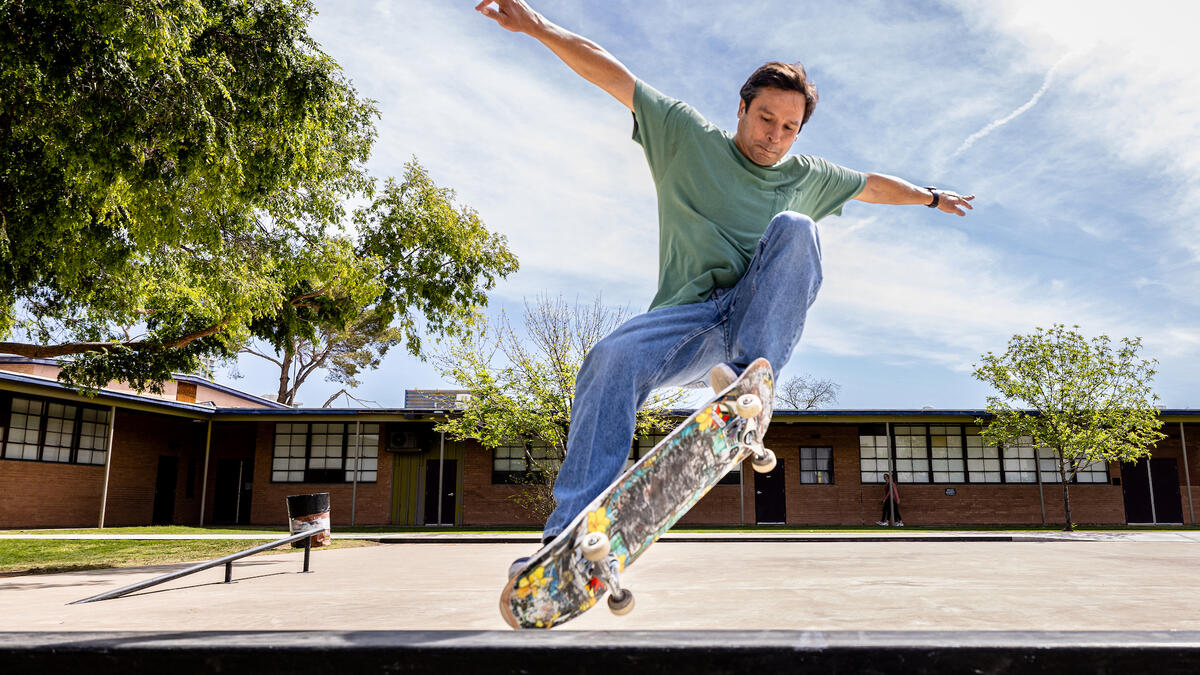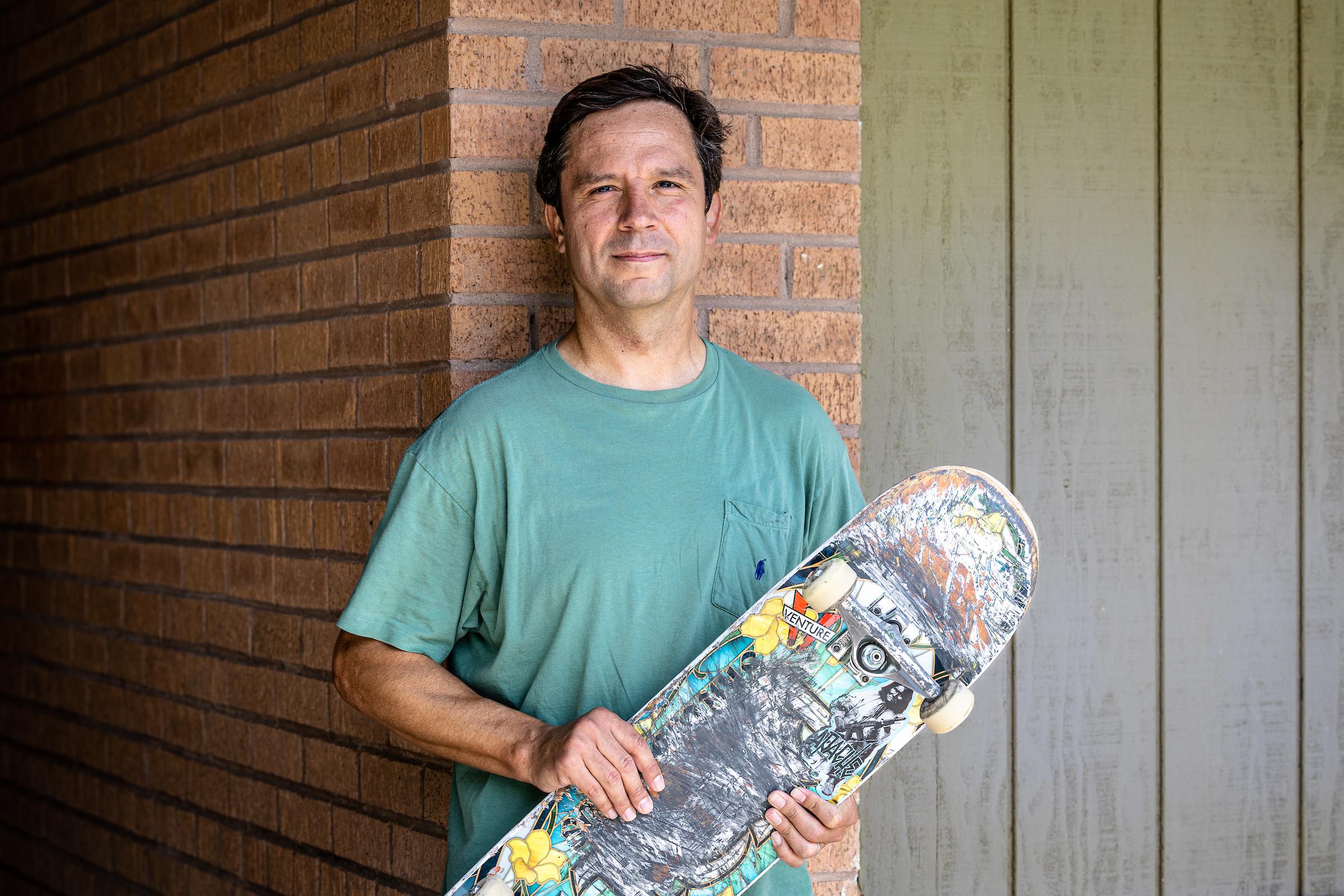Editor's note: New Faces on Campus is a new monthly feature by ASU News showcasing faculty members who have been hired in the 2022–23 academic year.
Taking a class from Maurice Crandall sounds like it could come with some serious twists and turns.
The Arizona State University professor is a respected historian, author, Indigenous expert — and a self-professed “skate rat.”
Crandall is a recent hire from Dartmouth College but considers himself a local. He’s also a new face on campus this year.
He joined ASU’s School of Historical, Philosophical and Religious Studies as an associate professor of history in August 2022 and is a historian of the Indigenous peoples (he’s a citizen of the Yavapai-Apache Nation of Camp Verde) of the U.S.-Mexico Borderlands. That sounds serious, which is why Crandall has a serious outlet — skateboarding.
He’s been doing it for decades and, at 44 years of age, still dedicates a fair amount of time to his hobby when he’s not teaching or researching.
ASU News spoke to Crandall about his life, work and research.
Maurice Crandell is a new face on campus this year, joining the School of Historical, Philosophical and Religious Studies as an associate professor of history. Photo by Charlie Leight/ASU News
Question: Can you tell us a bit about your background — where you’re from and how you ended up in academia?
Answer: I was raised in New Mexico and Arizona. I graduated from Mingus Union High School in Cottonwood, Arizona, so I’m a “local.” I’m a citizen of the Yavapai-Apache Nation of Camp Verde, Arizona, and I grew up hearing a lot of stories from elders and relatives, which I credit for my interest in history. All the stories I heard growing up informed my sense of what history is, and I have always loved both listening to and telling stories.
I went to grad school a little older after working various jobs — at Walmart, at my tribe’s casino, as a special education assistant in public schools — and never planned to be an academic. I thought I would be a public school history teacher. But my grandfather, who was like a second father to me, encouraged me to get a PhD since a higher education scholarship from our tribe would pay for it.
I completed a PhD in 2015 and worked as a public historian at the Indian Pueblo Cultural CenterA museum/archives/cultural center owned and operated by New Mexico’s 19 Pueblo Nations. in Albuquerque, New Mexico, followed by a one-year postdoctoral at the Clements Center for Southwest Studies at Southern Methodist University, and then got a tenure-track job at Dartmouth College, where I taught for five years. So, my path to being an “academic” was a long one that had lots of twists and turns.
Q: What is your area of research or academic focus? What are you most excited about regarding your research?
A: I’m a historian of the Indigenous peoples of the U.S.-Mexico Borderlands. This includes numerous groups, but I’ve researched and written about Yavapais, Western Apaches, O’odhams, Hopis, Yaquis and the Pueblos. Generally speaking, the homelands of all of these groups are located within what are today the states of Arizona, New Mexico and Sonora, Mexico. My research covers a broad chronology, from the late 16th century through the first half of the 20th.
I’m most excited about the project I’m currently working on, which is a book under contract with Liveright/W.W. Norton, about the lives and experiences of Yavapais and Dilzhe’e — commonly referred to as “Tonto” — Apaches who served as U.S. Army Indian Scouts during the so-called Indian Wars of the late 19th century. In particular, I’m interested in uncovering the experiences of these men, their families and communities after the wars were over and they returned to civilian life. Plenty of work has focused on their contributions to the military campaigns, but far less has addressed what they did later in life.
I’ve found that many of them became community leaders at a very difficult time, when the federal government was trying to eradicate Apaches and Yavapais through policies of dispossession and cultural genocide — Indian boarding schools, for example. These men were experienced border crossers — they had crossed state, international and ideological borders during their military service — and they used that knowledge to navigate a complex political/cultural landscape and advocate for our communities during the early 1900s.
Q: When did you realize you wanted to study this field? (What was your “aha” moment?)
A: I knew from a very young age that I had a passion for history. I loved listening to stories of the “old times” from my grandparents and other relatives and reading history books on a variety of subjects. I read lots of Native American history, obviously, but I also read about Roman history, the American Civil War, World War II and many other historical subjects. I liked visiting historic sites, museums and watching documentaries. In other words, I’ve always been a history nerd. I don’t think there was a single, identifiable “aha” moment. I declared history as my major during my first semester in college, and it stayed my focus through graduate school.
Q: How do you want to see this field advance to the betterment of society?
A: In the United States, more and more scholars, teachers and others are taking up the mantra that you can’t teach U.S. history without including Native American history. I would like to see that expanded to all history: You can’t teach any type of history without including Indigenous history. Whether its economic history, social history or even a narrow field such as maritime history, Indigenous peoples play a part in that history in some way. I want more scholars and teachers to include Indigenous voices in their work, and recognize the part that Indigenous peoples have played in the history of the world. Indigenous history runs as a prominent thread through all types of history, and I would like more people to recognize that. I see part of my work as demonstrating that to people.
Q: What is something you wish more people realized about what you research?
A: I wish people would see Native American history as a history of people finding creative solutions to issues they confront and moving forward in ways that worked for themselves, their families and their communities. I push back against triumphalist narratives, especially as it pertains to the “rights” of ethnic and historically disadvantaged communities in the U.S. For example, my first book is about Indigenous enfranchisement in the U.S.-Mexico Borderlands. A common idea is that there was this long struggle for voting rights, culminating in midcentury activism and court cases that finally extended the franchise to Native Americans, African Americans and others.
The reality is that Indigenous peoples in this region were enfranchised in a variety of ways during the Spanish, Mexican and U.S. periods. And at various times they adapted and incorporated so-called Western democratic ideals and practices, while at other times they rejected them and citizenship within the nation-state, instead focusing on community autonomy and sovereignty. I want people to recognize agency and sovereignty in Indigenous communities and their history, not just conquest and control by colonizers, with eventual rights bestowed by a benevolent nation-state.
Q: What brought you to ASU, and what do you like about the university?
A: I taught at Dartmouth College for five years. In essentially every way — climate, geography, culture — it is the opposite of Arizona. I was often homesick and had a strong desire to return to Arizona so that I could be closer to my family, community and homelands. I also got tired of only being able to do research during trips back to the West a few times per year. I wanted to live where my work is and be able to directly engage with the history. I wanted to be around tribal elders and archives and landscapes that are essential to my work. The opportunity to return to Arizona and work at ASU came about, and I jumped at it.
Also, working at an Ivy League institution was great in many ways, but I wanted to be at an institution that serves a more diverse student body. I wanted to engage with more students who come from backgrounds like my own. I also wanted to be at an institution that provided more opportunities for public-facing scholarship and engagement. ASU has provided all of this, and I really appreciate ASU’s mission to make education more accessible.
Q: What specifically would you like to accomplish while at your college/school/department?
A: On a personal level, when I came to ASU I received tenure, which felt amazing. Indigenous scholars and scholars of color face a lot of challenges in academia, and I am the first citizen of my tribal nation to become a tenured associate professor. I would like to become a full professor within a reasonable time frame, after I’ve finished my second book and other projects I’m working on. I’d also like to help my school, the School of Historical, Philosophical and Religious Studies, continue to be a hub for Indigenous history. History at ASU has a long tradition of producing exceptional scholars of and scholarship on Indigenous history going back many decades. I hope to carry on that tradition.
Q: What’s something you do for fun or something only your closest friends know about you?
A: Since I was a teenager — I’m 44 now — I have been a skateboarder. The amount of time I have dedicated to skateboarding has fluctuated over the years due to school, work, family and community commitments, but I try to skateboard every chance I get. I’m what many would refer to as a “skate rat.”
I’m also really happy that I’ve been able connect with the Native American skate community since I’ve been back in Arizona. There’s a thriving community of Native skaters and skate companies, with Doug Miles of the San Carlos Apache Tribe, who founded Apache Skateboards, and Doug Miles Jr. and the rest of the crew, leading the way.
Top photo: Associate Professor Maurice Crandall, who joined the School of Historical, Philosophical and Religious Studies at ASU in August 2022, pictured at the Mitchell Park skate park in Tempe. Photo by Charlie Leight/ASU News
More Arts, humanities and education

Local traffic boxes get a colorful makeover
A team of Arizona State University students recently helped transform bland, beige traffic boxes in Chandler into colorful works of public art. “It’s amazing,” said ASU student Sarai…

2 ASU professors, alumnus named 2025 Guggenheim Fellows
Two Arizona State University professors and a university alumnus have been named 2025 Guggenheim Fellows.Regents Professor Sir Jonathan Bate, English Professor of Practice Larissa Fasthorse and…

No argument: ASU-led project improves high school students' writing skills
Students in the freshman English class at Phoenix Trevor G. Browne High School often pop the question to teacher Rocio Rivas.No, not that one.This one:“How is this going to help me?”When Rivas…



